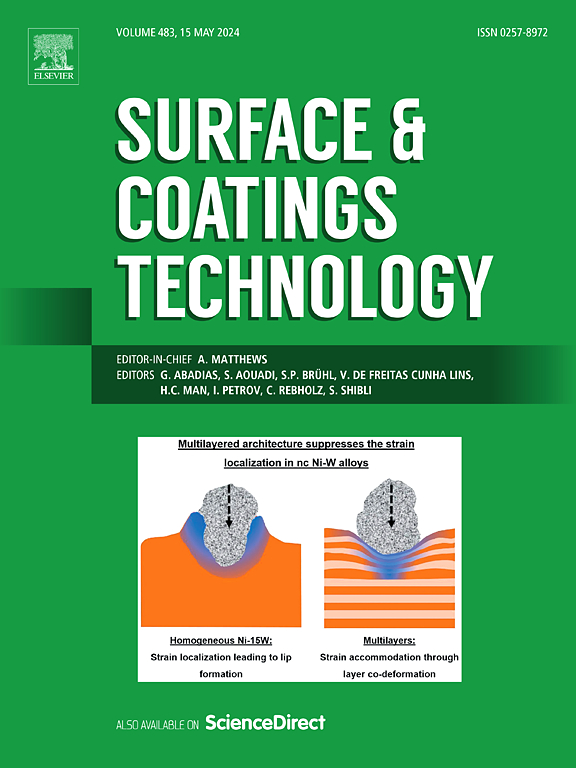Effects of silicon content on the characterization of (CrTaWSi)Nx thin films
IF 5.3
2区 材料科学
Q1 MATERIALS SCIENCE, COATINGS & FILMS
引用次数: 0
Abstract
(CrTaWSi)Nx films with 0–15.8 at.%Si were fabricated through magnetron cosputtering. The influences of Si content on the structural, mechanical, tribological, and antioxidative properties of (CrTaWSi)Nx films were evaluated. The films grew a face-centered cubic phase and amorphous structure as the Si content was <6.4 at.% and >12.5 at.%, respectively. The crystalline (CrTaWSi)Nx film with 6.4 at.%Si had the highest hardness and elastic modulus of 30.5 and 304 GPa, respectively. In contrast, the mechanical properties of the amorphous (CrTaWSi)Nx films were at low levels. Moreover, the films with higher hardness were ascribed to the nanocomposite formation, accompanied by higher wear resistance and lower coefficient of friction. The (Cr0.31Ta0.10W0.31Si0.28)N0.76 films with 15.8 at.%Si maintained an amorphous structure after annealing at 600 °C up to 24 h in the air accompanied by a surficial oxide layer restricting further oxidation.
求助全文
约1分钟内获得全文
求助全文
来源期刊

Surface & Coatings Technology
工程技术-材料科学:膜
CiteScore
10.00
自引率
11.10%
发文量
921
审稿时长
19 days
期刊介绍:
Surface and Coatings Technology is an international archival journal publishing scientific papers on significant developments in surface and interface engineering to modify and improve the surface properties of materials for protection in demanding contact conditions or aggressive environments, or for enhanced functional performance. Contributions range from original scientific articles concerned with fundamental and applied aspects of research or direct applications of metallic, inorganic, organic and composite coatings, to invited reviews of current technology in specific areas. Papers submitted to this journal are expected to be in line with the following aspects in processes, and properties/performance:
A. Processes: Physical and chemical vapour deposition techniques, thermal and plasma spraying, surface modification by directed energy techniques such as ion, electron and laser beams, thermo-chemical treatment, wet chemical and electrochemical processes such as plating, sol-gel coating, anodization, plasma electrolytic oxidation, etc., but excluding painting.
B. Properties/performance: friction performance, wear resistance (e.g., abrasion, erosion, fretting, etc), corrosion and oxidation resistance, thermal protection, diffusion resistance, hydrophilicity/hydrophobicity, and properties relevant to smart materials behaviour and enhanced multifunctional performance for environmental, energy and medical applications, but excluding device aspects.
 求助内容:
求助内容: 应助结果提醒方式:
应助结果提醒方式:


